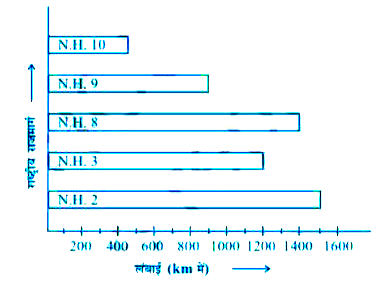The majority of National Highways in India have:
1 two-lanes
2 six-lanes
3 eight-lanes
4 four-lanes
Answer : 1. "two-lanes"
Related Solutions
The National Highway 7 is the longest highway in India. It connects
View SolutionNational Highways are the major roads connecting ...
View Solutionभारत का सबसे लंबा राष्ट्रीय राजमार्ग कौन-सा है ?
View SolutionWhich is the longest national highway in India?
View SolutionWhich is the longest national highway in India?
View SolutionGive a brief description of National Highways in India.
View SolutionQuestion Stimulus
Which is shortest National Highway in India?View SolutionWhich one of the following is the longest National Highway in India?
View SolutionWhich one of the following is the longest National Highway in India ?
View SolutionWhich is the second longest National Highway (NH) in India ?
View SolutionThe National Highways Network of India measures over 70,934 km as of 2010, including over 1,000 km of limitedaccess expressways. Out of 71,000 km of National Highways 15,000 plus km are 4 or 6 lanes and remaining 50.000 km are 2 lanes. The National Highways Authority of India (NHAI) is the nodal agency responsible for building, upgrading and maintaining most of the national highways network. The National Highways Development Project (NHDP) is a major effort to expand and upgrade the network of highways. NHAI often uses a public-private partnership model for highway development, maintenance and toll-collection. National highways constituted about 2% of all the roads in India, but carried about 40% of the total road traffic as of 2010. The majority of existing national highways are twolane roads (one lane in each direction), though much of this is being expanded to four-lanes, and some to six or eight lanes. Some sections of the network are toll roads. Over 30.000 km of new highways are planned or under construction as part of the NHDP, as of 2011. This includes over 2,600 km of expressways currently under construction.
The majority of National Highways in India haveView SolutionWhich one of the following is the longest National Highway (NH) in India?
View SolutionNational Highway-7 is the longest national highway in India, which traverses between Varanasi and Kanya Kumari. Identify the places en route from North to South.
View Solutionभारत में सड़क परिवहन का महत्त्व क्या है ? राष्ट्रीय महामार्ग राज्य महामार्गों से किस प्रकार भिन्न हैं ? भिन्नता के चार सूत्र लिखें।
View SolutionConsider the following statements and choose the correct option. A. NH-47A from Vembnad lake to Wellinton island is shortest National Highway in India. B. NH-7 from Varanasi to Kanyakumari is longest National Highway in India.
View SolutionIn the following questions, you have two passages with 5 questions in each passage. Read the passages carefully and choose the best answer to each question out of the four alternatives.
The National Highways Network of India measures over 70,934 km as of 2010, including over 1,000 km of limited - access expressways. Out of 71,000 km of National Highways 15,000 plum km are 4 ot 6 lanes and remaining 50,000 km are 2 lanes. The National Highways Authority of India (NHAI) is the bodal agency responsible for building, upgrading and maintaining most of the national highways network. The National Highways Development Project (NHDP) is a major effort to expand and upgrade the network of highways. NaHI often uses a public - private partnership model for highway development, maintenance and toll - collection. National high-ways constituted about of all the roads in Inida, but carried about of the total road traffic as of 2010. The majority of existing national highways are two - lane roads (one lane in each direction), though much of this is being expanded to four - lanes, and some to six or eight lanes. Some sections of the network are toll roads. Over 30,000 km of new highways are planned or under construction as part of the NHDP, as of 2011. This includes over 2,600 km of expressways currently under construction.
The majority of National High ways in India have:View Solutionभारत के कुल राष्ट्रीय राजमार्गों की लंबाई निकटतम किलोमीटरों में, निम्न दंड-आलेख द्वारा निरूपित की गई है। दंड-आलेख पढ़िए और निम्नलिखत प्रश्नों के उत्तर दीजिए

(a) उपरोक्त में से कौन-सा राष्ट्रीय राजमार्ग सबसे अधिक लंबा है?
(b) उपरोक्त में से कौन-सा राष्ट्रीय राजमार्ग सबसे छोटा है?
(c) राष्ट्रीय राजमार्ग 9 की लंबाई कितनी है?
(d) किस राष्ट्रीय राजमार्ग की लंबाई, राष्ट्रीय राजमार्ग 10 की लगभग तिगुनी है?View SolutionThe bar graph given below represents approximate length (in kilometres) of some National Highways in India. Study the bar graph and answer the following questions:

Length of which National Highway is about three times the National Highway10?View Solutionदो राष्ट्रीय राजमार्ण कन्याकुमारी -श्रीनगर राजमार्ग एवं पोरबन्दर- सिलवर राजमार्ग, जो राष्ट्रीय राजमार्ग विकास परियोजना के अन्तर्गत निर्मित हो रहे हैं, एक-दूसरे से मिलेगे
View SolutionThe National Highways Network of India measures over 70,934 km as of 2010, including over 1,000 km of limitedaccess expressways. Out of 71,000 km of National Highways 15,000 plus km are 4 or 6 lanes and remaining 50.000 km are 2 lanes. The National Highways Authority of India (NHAI) is the nodal agency responsible for building, upgrading and maintaining most of the national highways network. The National Highways Development Project (NHDP) is a major effort to expand and upgrade the network of highways. NHAI often uses a public-private partnership model for highway development, maintenance and toll-collection. National highways constituted about 2% of all the roads in India, but carried about 40% of the total road traffic as of 2010. The majority of existing national highways are twolane roads (one lane in each direction), though much of this is being expanded to four-lanes, and some to six or eight lanes. Some sections of the network are toll roads. Over 30.000 km of new highways are planned or under construction as part of the NHDP, as of 2011. This includes over 2,600 km of expressways currently under construction.
What is the measurement of two-lane National Highways of India ?View Solution
